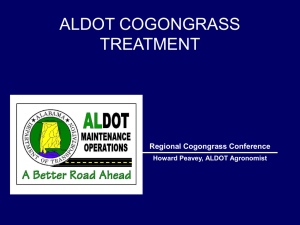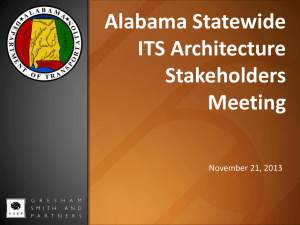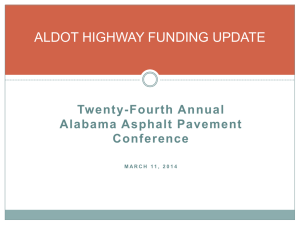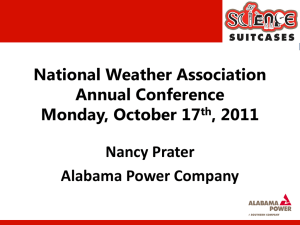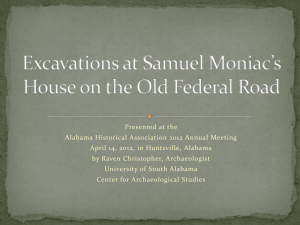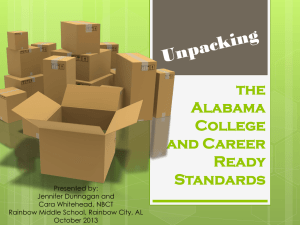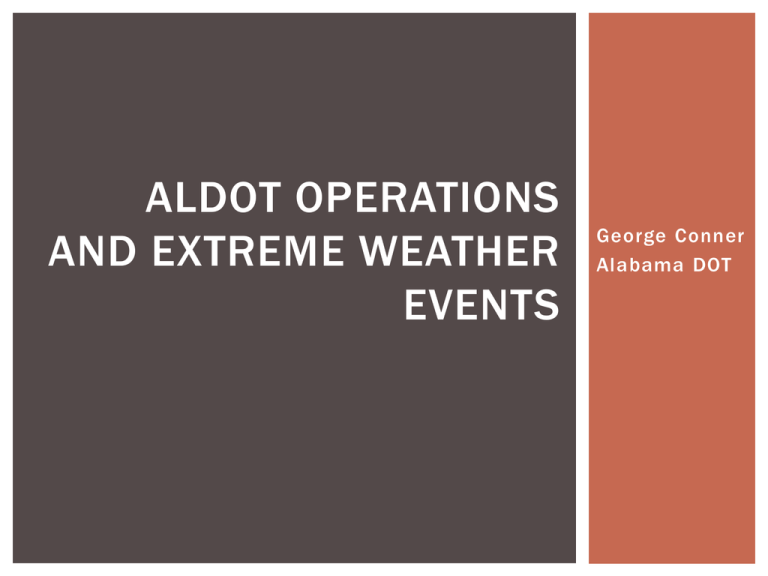
ALDOT OPERATIONS
AND EXTREME WEATHER
EVENTS
George Conner
Alabama DOT
EXTREME WEATHER
EVENTS AFFECTING
ALABAMA
HURRICANES
2005 Season
• Arlene
• Cindy
• Dennis
• Katrina
• Rita
A f f ec te d A L D OT
in one form
or another
TORNADOS
SIGNIFICANT WET AND DRY CYCLES
2007
2009
SIGNIFICANT WET AND DRY CYCLES
Average Annual Rainfall
2009 Rainfall
SNOW AND ICE
Small events
compared to many
other states
Huge impact within
the state
Tend to be icy events
IMPACT OF EXTREME
WEATHER EVENTS ON
ALDOT O&M
IMPACTS TO ALDOT O&M
Pace of events has increased
Severity of events has increased
Public expectations have increased greatly
Particularly the degree of government response that is expected
Costs associated with events have risen
Impact of recovery costs on maintenance budgets continues to
increase
Impact of recovery ef fort on ability to perform regular
operations has increased
Especially due to compliance with debris removal requirements
Has forced Region, Division and District personnel to gain
experience and develop expertise in administering recovery
ef forts
Impacted infrastructure directly impacts ALDOT O&M
ROADWAY
FAILURES
Hurricane Ivan
SINKHOLES
I-65 in Morgan
County
L a r g e t r a f fi c
management
r e q u i r em e n t
(all NB
i n te r s t a te
t r a f fi c o n
d eto ur )
SINKHOLES
I-65 in Morgan
County
SLOPE
FAILURES
(SMALL)
M o b i le C o u n t y
SLOPE
FAILURES
(LARGE)
Ru s s e l l C o u n t y
SLOPE
FAILURES
(EVEN
LARGER
REPAIR)
Ru s s e l l C o u n t y
ADJUSTMENTS TO O&M
DUE TO EXTREME
WEATHER
CHANGES TO ALDOT O&M
Emergency Management has become a full time job
Was an additional duty for many years
Now assigned to a full time staff member
Assistant Bureau Chief level – same as other maintenance functional
areas
Improved and strengthened relationship with State Emergency
Management Agency
Greatly increased need for recurring training in
Region/Divisions and Districts
Focus on specific “smaller” solutions
Portable Highway Advisory Radios (HARs)
Coordination across and between Divisions
Less specialized equipment
O&M LESSONS LEARNED
“DESIGN” VERSUS “RESPONSE”
Designing a transportation system to cover all extreme events
at every location where a failure may occur falls between:
Impractical and wildly expensive
Impossible
“Design vs. Response” decision is risk -based
Quantitative, formal process is sensitive to assumptions.
Qualitative, informal process is influenced by past response
performance.
Alabama performed formal risk-based analysis with TSA. Only one
asset in the entire state was identified as a candidate for design based mitigation of risk.
DOTs tend to perform well in response -mode
Make use of that capability
DON’T BE
SURPRISED
BY
ANY THING
Hurricane
Katrina
Floating oil
p l a t fo r m
wedged under
Cochrane
Bridge, Mobile
County
ALDOT O&M BEST
PRACTICES
ALDOT O&M BEST PRACTICES
Improved Program Management of Recovery Ef forts
ER
FEMA
ALDOT Internal processes for managing events and post-event audits
Full time Assistant Bureau Chief over Emergency Management
Increased focus on continuance of operations
Refined philosophy regarding response to an event versus
designing for an event
Revised practices for removing trees from ROW
Use of expedited procurement practices (Code of Alabama)
Does not require Governor to issue a State of Emergency (SOE)
ALDOT O&M BEST PRACTICES
Dissemination of Road Condition information
Everyday events
Large scale events (call center)
Improved systems and practices for moving OS/OW traf fic
before, during and after an event
Reduced need for waivers and proclamations
Better communication within ALDOT during an event
Video Conferences
Phone bridges
Use of portable video surveillance equipment ( EarthCam)
DEVELOPED
CONTRA FLOW
PLAN
N o t a s h e l p f ul
as first
ex p e c te d
Ve r y d i f fi cul t to
ex e c ute – m u s t
ex e r c is e
P r e p a r e to u s e
it … but work
l i ke c r a z y to
av o i d i t
QUESTIONS?

